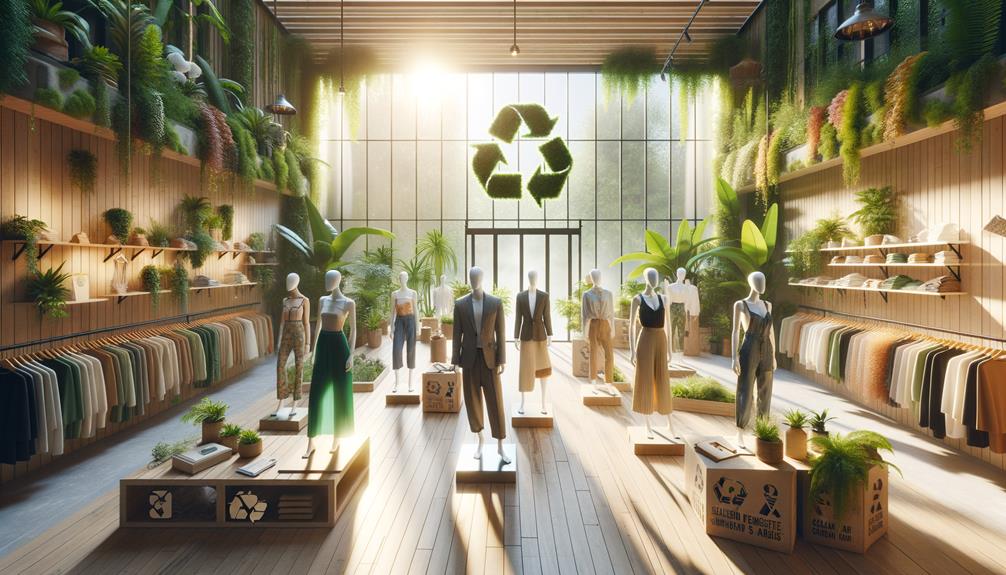I've witnessed the fashion industry's harmful impact unfold, and embracing sustainable fashion is now crucial. The journey began in the early '90s with brands like Patagonia and ESPRIT. Today, the stakes are higher – fashion accounts for 4% of global greenhouse emissions and over 60% of discarded clothes end up in landfills. But change is happening through recycling, upcycling, and innovative business models like rental services. Brands now offer product guarantees and repair services to extend the life of garments. The future looks promising, with community engagement and cutting-edge materials. There's much more to explore in this evolving landscape.
History of Sustainable Fashion
Sustainable fashion has quietly been taking shape since the early 1990s. Brands like Patagonia and ESPRIT were among the first to address environmental concerns in the industry. It's fascinating to see how these pioneers made the initial ripples that have since become a transformative wave.
These early companies took a hard look at the environmental impact of fashion production, from raw materials to water pollution. ESPRIT's e-collection, launched in 1992, was a notable milestone. It was based on the Eco Audit guide and embodied sustainable practices that were exceptional for the time. This move wasn't just about marketing; it was a genuine effort to rethink how clothes are made. It's clear they were planting seeds for future change.
Lifecycle assessments of fibers during this period provided deeper insights into the environmental impact of different materials. Knowing these assessments played a vital role makes one appreciate the foundation they built for today's sustainable practices. Given fashion production has always been resource-intensive, these early efforts were pivotal in revealing how deeply interconnected our clothing choices are with the planet's health.
Reflecting on this, the early 90s were the quiet beginnings of a louder, more sustainable future for the fashion industry.
Environmental and Social Concerns
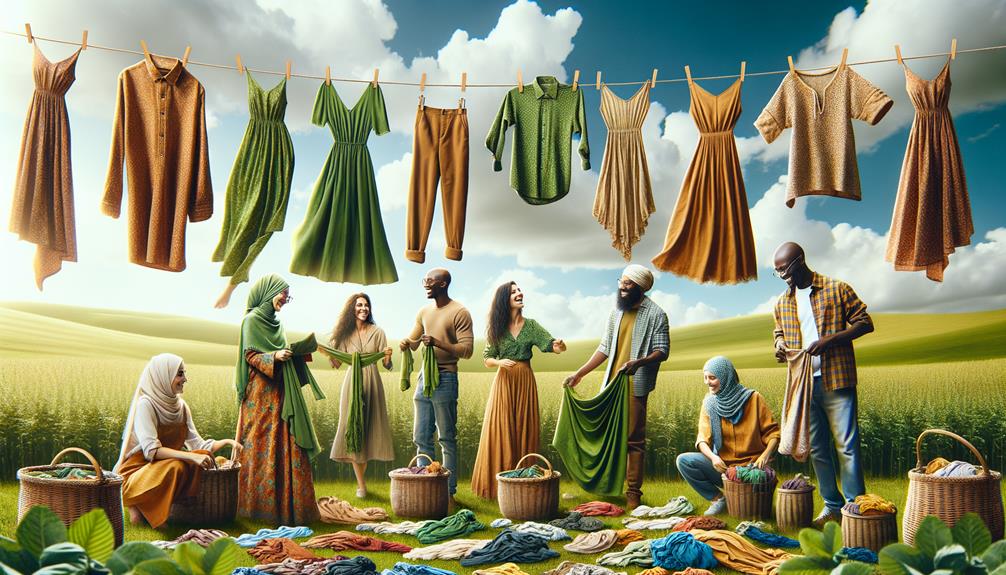
The fashion industry is intricately linked to both environmental degradation and social exploitation, though these impacts are often overlooked. The environmental toll is staggering, with the industry responsible for 4% of global greenhouse gas emissions. At this rate, apparel production is projected to account for 26% of carbon emissions by 2050. This isn't just about numbers; it's about the very air we breathe and the planet we inhabit.
Over 60% of clothes end up in landfills, contributing nearly 20% to global waste. Toxic dyes and heavy metals from manufacturing also contaminate water sources. Meanwhile, factory workers often face poor working conditions and are paid less than minimum wage.
The human cost is undeniable. Factory workers are subjected to grueling hours and unsafe working conditions, with a lack of regulation in this massive sector only exacerbating these issues. Sustainable fashion offers a glimmer of hope, but it requires a collective shift in how we produce and consume clothing.
Clothing consumption is expected to triple by 2050. If we don't change our ways, both social injustice and environmental damage will only escalate. Innovation in sustainable practices is not just desirable – it's imperative.
Sustainable Business Models
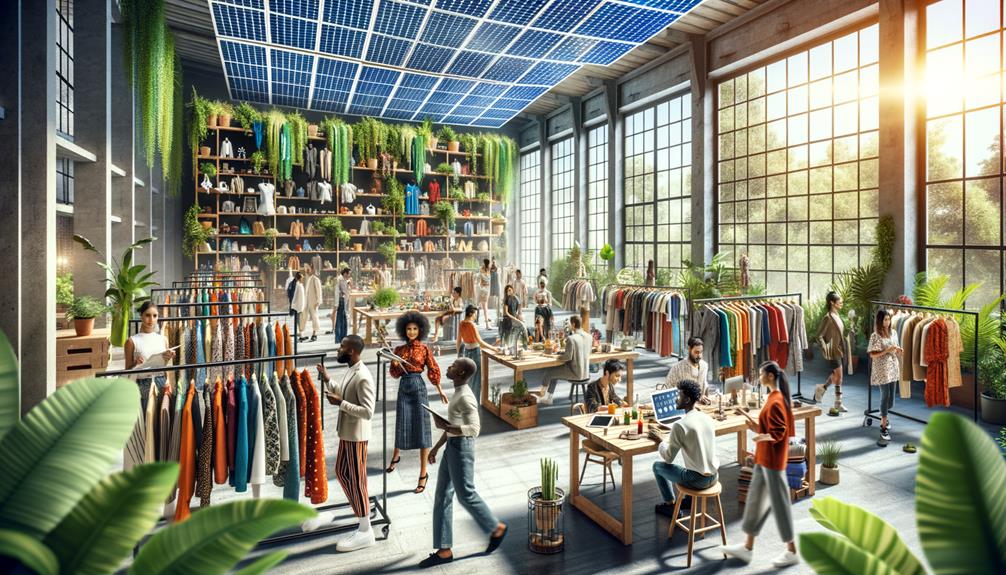
In exploring new ways to consume fashion, rental and resale models offer a promising shift. Rather than continually buying and discarding clothes, these models allow us to participate in a circular economy. Brands like Rent the Runway and thredUP make it easy to access outfits without the need for ownership, reducing waste and over-consumption.
Subscription services like Nuuly provide a rotating wardrobe, embracing sustainable consumption. The ability to refresh our outfits regularly without the environmental toll of fast fashion feels innovative and necessary. Brands such as Patagonia and Eileen Fisher go further by offering lifetime product guarantees and repair services, promoting longer product use and reducing the need for new items.
| Model | Examples |
|---|---|
| Rental | Rent the Runway, Nuuly |
| Resale | thredUP, Poshmark |
| Lifetime Guarantee | Patagonia, Eileen Fisher |
Reuse and Recycling
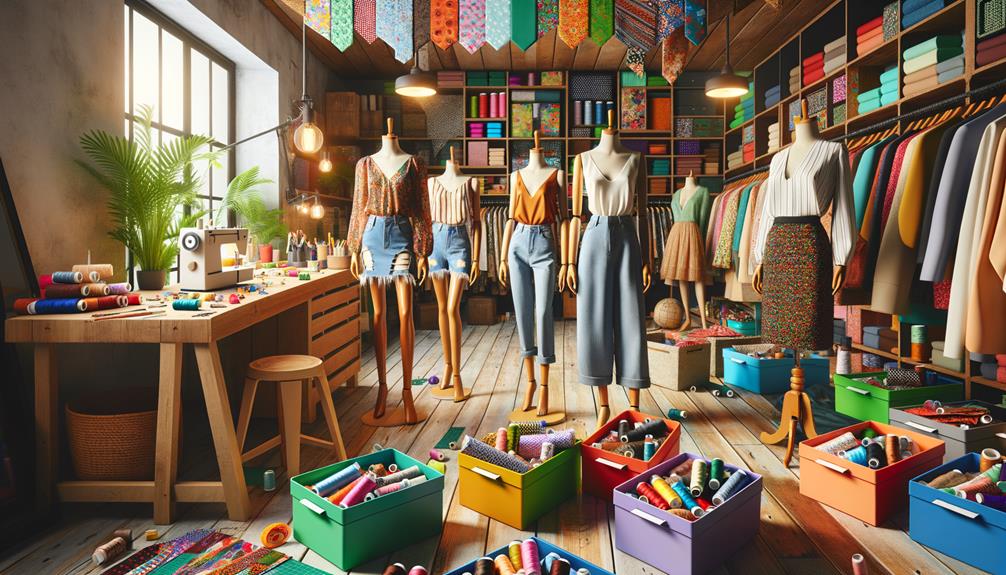
I'm really interested in the potential of reusing old clothing through upcycling. Thrifting feels like a small but meaningful way to reduce textile waste and give garments a second life. There's something satisfying about discovering hidden gems at second-hand stores and giving them new purpose. While it may not solve the whole problem, every little bit helps when it comes to cutting down on the massive amounts of clothes that end up in landfills. I find the whole concept of breathingNew life into old items to be really fulfilling.
Upcycling Old Clothing
Upcycling old clothing isn't just a passing fad; it's a necessary shift towards sustainability. When I think about the environmental toll of clothing production – how it depletes water resources and strains the supply chain – it's clear we need to rethink our habits. Upcycling offers a solution that's both innovative and practical.
It reduces the environmental impact of fast fashion. It transforms waste into unique, high-value items. And it empowers consumers to practice sustainability in their daily lives.
By creatively repurposing garments, upcycling extends the lifespan of our clothes and diminishes the need for new production. Brands like E.L.V. Denim have mastered this, using 100% upcycled materials to make timeless designs. Each piece tells a story, reflecting a commitment to sustainability and creativity.
Engaging in upcycling allows me to take a stand against the wastefulness of the fashion industry. It's a mindful approach to fashion that acknowledges our planet's limits. By choosing upcycled clothing, I'm not just making a style statement; I'm advocating for a more sustainable future. This shift isn't merely about fashion – it's about fostering a deeper connection to the world and our resources.
Textile Waste Reduction
While upcycling breathes new life into old garments, the broader challenge lies in reducing textile waste through effective reuse and recycling. The fashion industry churns out over 100 billion garments annually, yet a staggering 87% end up in landfills or incinerated. This stark reality makes me question our clothing consumption habits. Can we find solutions?
Only 1% of discarded clothing is recycled, a sobering statistic that signals how far we must go. We're at Fashion Week, celebrating new trends, but how often do we think about the aftermath? The use of recycled fabrics isn't just a trend; it's a necessity. Washing synthetic clothing releases microplastics into our oceans, and this pollution accounts for 35% of the total. We need to embrace more sustainable materials.
Being socially responsible means rethinking how clothes are made and consumed. The global fashion industry contributes 4% of greenhouse gas emissions. If we don't change, clothing consumption is set to triple by 2050. Imagine the environmental toll. It's critical we adopt effective waste reduction strategies now. Our choices today will shape the fashion landscape of tomorrow.
Thrift Store Shopping
Among the many ways to reduce our environmental impact, shopping at thrift stores stands out as a practical and effective choice. When I step into a secondhand shop, I'm reminded of the true cost of fast fashion. Each garment tells a story – of resources saved, landfill space spared, and a shift in consumption patterns.
The environmental benefits of thrifting are clear. Extending the life of clothes reduces the demand for new production practices that strain natural resources. Economically, secondhand shopping can save up to 80% on clothing costs, making sustainable fashion more affordable.
Many thrift stores also fund local initiatives, creating a positive cycle of giving back to the community. Buying secondhand isn't just about saving money – it's about acknowledging the unseen labor of garment workers and the environmental toll of fast fashion. By choosing thrift stores, we support a system that values reuse and recycling, diverting over 2 million tons of textiles from landfills annually in the U.S.
In a world driven by constant consumption, thrift store shopping offers a minimalist yet innovative approach. Through this simple act, we contribute to a more sustainable future, one preloved item at a time.
Consumer Engagement
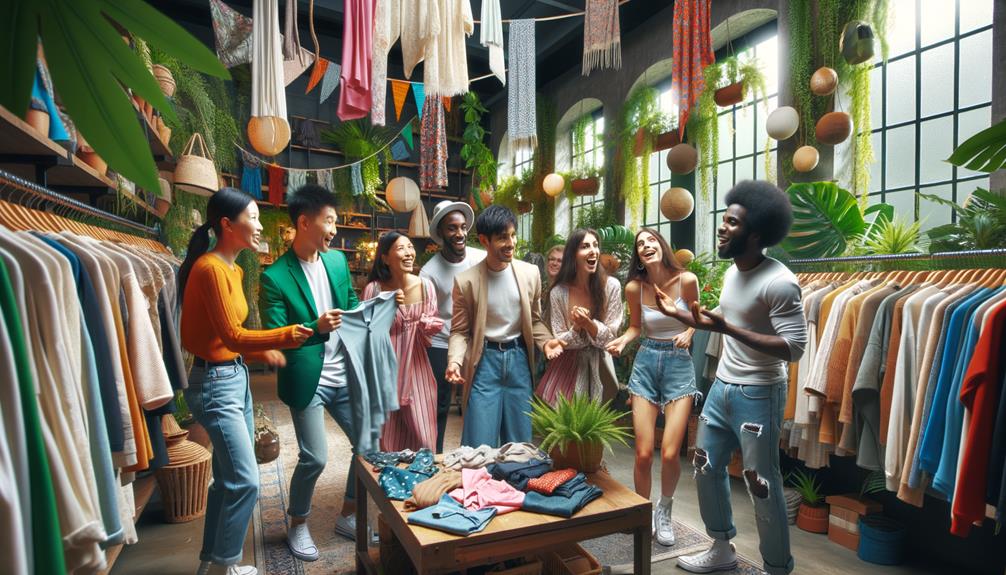
Sustainable fashion can often feel inaccessible, but finding ways to make it more engaging for everyone is crucial. Social media campaigns with interactive elements and reward programs could help get people excited about sustainable choices. Building a community around these initiatives could turn individual actions into a larger movement that inspires change.
Rather than lecturing, we should focus on making sustainable fashion fun and rewarding. Highlighting real people's stories and making it easy for the average consumer to participate could go a long way. The goal should be to present sustainable fashion as an empowering lifestyle, not just an obligation.
Ultimately, making sustainable fashion more engaging comes down to understanding what motivates people and giving them the tools and support to make greener choices part of their daily lives. It's about creating a sense of shared purpose, not preaching from above.
Interactive Social Media Campaigns
Through interactive social media campaigns, brands like H&M and Patagonia have changed how we engage with sustainable fashion. These initiatives go beyond simple marketing; they bridge the gap between fast fashion and the slow fashion movement, fostering a sense of social and environmental responsibility. For instance, H&M's #YourTurnChallenge on TikTok encouraged users to showcase thrifted outfits, drawing attention to secondhand shopping and amassing over 3.1 billion views. It was a powerful reminder that sustainable choices can be both fashionable and impactful.
Patagonia's 'Don't Buy This Jacket' campaign on Black Friday exemplified anti-consumerism by urging customers to purchase only what they need. Reformation's 'We Are What We Do' initiative provided carbon footprint transparency. These campaigns often coincide with significant dates like Earth Day, urging consumers to reflect on their habits.
It's fascinating how brands are using social media to create meaningful dialogues and encourage more mindful consumption patterns. This shift towards transparency and participation is shaping the future of sustainable fashion, proving that innovation and responsibility can coexist.
Reward Programs Incentives
Reward programs have become an interesting way for fashion brands to engage customers in sustainable practices. These initiatives are leading the charge towards more eco-friendly consumption models. Programs like Nuuly's rental service and Patagonia's 'Worn Wear' repairs promote clothing longevity and circularity.
Governments should examine how these programs impact water usage per garment and waste reduction. Nuuly's subscription lets people rent stylish pieces monthly, minimizing the need to buy new clothes. Patagonia's program repairs damaged items, extending their lifespan. These models show that every piece of clothing can have a prolonged lifecycle.
Here are some innovative reward programs:
| Brand | Incentive |
|---|---|
| Nuuly | Monthly rentals to promote circularity |
| Patagonia | Credit for returned, repairable items |
| ASOS | Points for eco-friendly actions |
These initiatives reflect a move towards sustainable fashion. Governments should support and amplify these efforts to make eco-friendly fashion the norm, not the exception.
Community Building Initiatives
Building a sense of community around sustainable fashion can deepen consumer engagement and loyalty. Brands like Reformation and Patagonia are leading the way, selling sustainable fashion while cultivating communities that value transparency, activism, and responsible consumption.
Reformation inspires customers to adopt sustainable lifestyles through their fashion choices. Everlane promotes a circular economy with their 'Choose What You Pay' model. Patagonia advocates for policy changes and climate action.
Brands addressing issues like greenhouse gas emissions and unsustainable clothing production are taking meaningful steps. The United Nations has highlighted the importance of reducing emissions, and these companies are making actionable progress. Sustainable fashion isn't just about natural fibers; it's about creating a culture that prioritizes the planet over profit.
Community-building initiatives create a sense of belonging, empowering consumers to make informed choices and feel part of something larger. The innovation lies in the collective effort to reshape the industry for a greener future. By fostering community, consumers aren't just buying clothes; they're investing in a sustainable world.
Innovations in Materials and Production

The fashion industry is tackling its environmental impact by exploring new materials like recycled polyester and Tencel. Polyester production, which amounts to millions of tons yearly, is notorious for its negative environmental effects. By shifting to recycled polyester, brands are rethinking the fabrics used in their collections, reflecting a commitment to sustainability and innovation.
We're seeing a change in how we approach materials and production. Organic cotton and hemp are gaining popularity, reducing the need for harmful pesticides. Tencel, derived from wood pulp, offers a biodegradable alternative. Technologies like laser-cutting and digital printing minimize waste, making the production process more efficient and sustainable.
Circular design principles are fascinating. Clothing designed for easy repair, reuse, or recycling signifies a shift towards longevity. Initiatives like garment leasing and resale platforms are redefining ownership, bringing us closer to a circular economy in fashion where resources are continuously repurposed.
Sustainable fashion accelerators and innovation challenges are pushing boundaries, incubating new ideas and solutions to environmental challenges. Each innovation, no matter how small, feels like a step toward a more sustainable future.
Frequently Asked Questions
What Are the 7 Rs of Sustainable Fashion?
The seven Rs of sustainable fashion are: rethink, refuse, reduce, reuse, repair, recycle, and repurpose. Each step encourages mindfulness and sparks creativity. It's fascinating how small choices can drive innovation and promote a sustainable lifestyle. Rethinking our clothing habits, refusing to buy into fast fashion, and reducing consumption are important first steps. Then, finding ways to reuse and repair garments, recycle textiles, and repurpose existing items keeps them out of landfills. This holistic approach highlights how every decision, big or small, can make a difference in reducing fashion's environmental impact. It's an empowering framework that puts the power in the hands of consumers to be part of the solution.
Why Is Sustainable Fashion an Issue?
Fashion's environmental impact is concerning. The industry's traditional practices often harm our planet and resources. We need innovative solutions to balance style and sustainability.
The fashion sector's huge carbon footprint, water usage, and textile waste are major issues. Clothes production has doubled in the past 15 years, with much ending up in landfills. Fast fashion's low prices and high turnover contribute to overconsumption and pollution.
Sustainable fashion aims to reduce this environmental toll through eco-friendly materials, ethical manufacturing, and circular business models. Consumers are also demanding more transparency and accountability from brands. By rethinking how we design, produce, and consume clothing, we can work towards a greener, more responsible industry.
Which Brands Are Sustainable Fashion?
Patagonia, Stella McCartney, Reformation, Everlane, and Gabriela Hearst are some brands that are leading the way in sustainable fashion. They're pushing the boundaries by using recycled, organic, and leftover materials in their designs. I admire how they're innovating and committing to ethical practices throughout their business.
Is Zara a Sustainable?
Zara's commitment to sustainability is often questioned. While the company has taken some eco-friendly steps, its fast fashion business model remains fundamentally unsustainable. The focus on rapid production and consumption overshadows genuine environmental responsibility. To truly address the sustainability challenge, Zara would need to undergo a significant shift in its core operations.
Conclusion
Reflecting on sustainable fashion, I'm struck by how style and sustainability work together. It's all about the choices we make – conscious, thoughtful, and caring ones. From recycled materials to fair labor practices, every step counts. I see hope in consumers who are craving change. Innovations inspire me, and together, we're building a future where fashion nourishes the world around us. It's an ongoing journey, but I'm optimistic. Let's take mindful, meaningful, and magnificent steps towards sustainable style.




